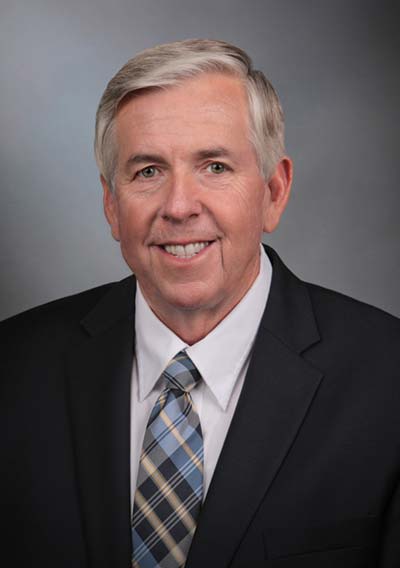“We need to step up our game.”
From the day Missouri Governor Mike Parson stepped into office, he charged all of state government to bear in mind that whether they’re paving highways, processing lower tax bills or refreshing the bulletin board for that third-grade classroom, they’re all engaged in building economic development and prosperity for the entire state.
There’s really no choice in today’s competitive environment. Missouri has lagged its peers and neighbors in too many areas, and there are two parallel paths to catch up.
“From day one, we’ve stayed focused on workforce development and infrastructure,” Gov. Parson says as he zips to a meeting after just returning from a trade mission to Australia, which followed close on the heels of a European trade mission earlier in the summer. “Around the world, the number one issue is workforce development — trying to get qualified employees, retain the ones you have and, most importantly, replace those employees headed for retirement. We’ve heard that loud and clear from the CEOs we’ve dealt with.”
That means reforming and recalibrating education, where Gov. Parson says there’s good news.
“The K-12 system, trade schools, community colleges and universities are starting to really get on the same page,” he says. The number of students graduating from Missouri colleges and universities increased by about 15% from 2011 to 2017. The largest increases have occurred at community and technical colleges, which graduated 24% more students in 2017 than 2011, and public universities, which graduated 21% more students in the same time period.
“It’s important to me as governor,” Parson says. “How do I retain those young people in the state of Missouri?”
After a statewide listening and learning tour led by his economic development and higher education chiefs, a series of executive orders and laws are making it easy for talent and employers alike to plant a stake and thrive in the Show-Me State.
“It was not the typical roundtable,” says Missouri Director of Economic Development Rob Dixon. “We did not go in with a pre-set list of things we wanted to do. We had people rolling up their sleeves and helping us develop policies along the way.”
“If you’re going to have a statewide initiative, you have to talk to people,” says Missouri Commissioner of Higher Education Zora Mulligan. One insight in particular stuck with Mulligan.
“Toward the end of the year, in Sikeston, an owner of a wire manufacturing company observed there was a time in the United States when we thought we were no longer going to make things anymore, and we adjusted our education system accordingly. Now we know we are going to make things, and it’s time to catch up.”
Missouri Makeover
Gov. Parson in January 2019 signed multiple executive orders that set in motion a major restructuring of four state agencies in order to improve economic and workforce development. The orders came after months of scrutiny.
“What we found was that our numbers are trending positive, but we’re not seeing anywhere near the growth that our competitor states are,” Dixon said then. “Our organization wasn’t built around our customers,” he said, calling the old way “a one size fits none approach.”

The team is just getting started, but the transparent, public way the work has been carried out thus far already has attracted positive attention.
“We have a series of maxims that guide our work, and one is, ‘Fortune favors the brave,’ ” Mulligan says. The willingness to admit where departments fell short resonated with the public and with state government staff. That candor combined with a sense of urgency among business leaders and elected officials to bring about the sweeping changes.
The research combined with feedback gathered from nearly 4,000 Missourians to help formulate the changes. Among them: Establishment of a new Regional Engagement Division that will reassign existing staff, with teams located in the regions they serve.
The changes also move the Division of Workforce Development under the Department of Higher Education. New workforce initiatives within the department include MoExcels, one-time funds for colleges and universities to expand high-demand programs; and a new Office of Apprenticeships. Currently, Missouri has nearly 500 registered apprenticeship programs and almost 15,000 active apprentices.
Among the 18 projects receiving $16.3 million through the new MoExcels program are the Ozarks Technical Community College Center for Advanced Manufacturing; the St. Louis Community College Talent Pipeline: Nursing and IT; and the Moberly Area Community College Mechatronics Center of Excellence.
‘Watershed Moment’
Last but not least, Gov. Parson’s orders shifted some divisions to better align certain policy areas with other state agencies.
In other words, it was time to get down to business.
When SB 68 was signed into law by Gov. Parson in July, it enacted four key follow-on pieces of legislation:
- Missouri Fast Track: Fills workforce gaps through financial aid for adult learners pursuing education and training in high-demand industries, helping meet the state’s goal of 60% of working-age adults having a high-quality certificate or degree by 2025.
- Missouri One Start: Improves Missouri’s workforce programs that help businesses recruit, onboard, and train large numbers of job applicants during major expansions.
- Missouri Works Deal Closing Fund: Gives Missouri a negotiating tool to close deals with companies by granting tax credits earlier in a business expansion and includes a clawback provision. Tax credits can be issued in the initial year, when the company needs to offset startup costs. Depending on the available cap space each year, up to $25 million would be set aside within the existing Missouri Works cap — no new program or dollars are required.
- Automotive Economic Development Tools: Helps retain automotive jobs by granting $5 million in tax credits annually to automotive manufacturers that invest $500 million or more in plant upgrades and agree to retain current workers.
The automotive piece was put into place specifically to support the major GM and Ford plants in the state as they mull potential expansions. Gov. Parson adds, “Honestly, it’s the subcontractors that will make a difference. There are 1,200 auto suppliers in our state.”
“These incentives are designed to build on the $2 billion in investment our state has seen in our automotive manufacturing facilities in recent years,” says Subash Alias, CEO of Missouri Partnership.
As for Fast Track, he says, “The skills mismatch throughout the United States has long been a challenge for companies and workers alike. Fast Track is Missouri’s newest tool to take this challenge head-on. The combination of Missouri One Start and Fast Track puts Missouri in the lead for workforce development solutions.”

Alias calls the deal closing fund “a game-changer for us. The program enhances the already competitive Missouri Works program by enabling us to offer companies the traditional five-year value of that program up front. Should companies perform a side-by-side present value evaluation of competing state programs, Missouri becomes that much more competitive.”
In separate actions, tort reform has made headway, and a steady drop in the corporate income tax will continue in January 2020 when it reaches 4%. Those actions “send a loud signal to corporations outside of the state about why it’s important to take a look at Missouri,” says Gov. Parson.
Learning and Doing
Zora Mulligan says many economic development conversations about target sectors would not include teaching or healthcare because those don’t necessarily bring businesses into the state. But in a sense, they do. “If you’re talking about community vitality and health, you have to consider healthcare and education as part of the equation,” she says, providing a human infrastructure alongside the state’s physical assets.
On a parallel track is a proactive shift by the four-campus University of Missouri System to encourage innovation and collaboration, and keep a college education affordable and accessible. UM System President Mun Choi last year announced $260 million in investments for strategic priorities over the next five years, including $100 million in new scholarships and $50 million to support research and creative works. The plan also includes the appointment of Bill Turpin, CEO of the Missouri Innovation Center, to lead economic development efforts for MU’s flagship campus in Columbia as well as the UM System, which is also moving forward in tandem with Siemens Healthineers on a new NextGen Precision Health Initiative.

“From day one we’ve stayed focused on workforce development and infrastructure.”
Mulligan says her primary task now is to blend the departments of workforce development and higher education into a single organization. She’ll be making sure communities are aware of the promise of Fast Track. And on the heels of a new report from the state’s department of education (K-12) that clearly prioritizes workforce development, she’ll be partnering with the Secretary of Education. “That’s the next critical step for us,” she says.
Dixon says the infrastructure work continues apace too. Since voters rejected an increase to one of the lowest gas taxes in the nation, but the state still has to maintain the nation’s seventh largest highway system, Gov. Parson proposed and legislators passed a $301-million bonding package that leverages the state’s AAA bond rating. He also created a $50 million cost share program for infrastructure projects, a $5 million cost-share program for broadband (leveraging $260 million from the federal government for rural broadband) and the state received an $81 million grant to improve a crucial bridge crossing in the middle of the state.
A Truce At Last
Dixon says he’s seen regional chambers, cities and counties already building on the momentum and changing their own economic development policies and strategies. That includes Kansas City, where some historic news occurred in August, as Gov. Parson and Kansas Gov. Laura Kelly signed an agreement to end the “border war” involving incentives awarded to companies for simply skipping back and forth across the state line. The Hall Family Foundation looked at moves between Johnson and Wyandotte Counties in Kansas and Jackson County in Missouri and estimated that more than 10,000 jobs moved between the two states in the last decade, for an incentive cost of some $330 million.
“I reached out to Governor Kelly and talked to her on several occasions, and we stayed focused,” says Gov. Parson of the incentives truce effort that finally got across the finish line. “Bottom line, we were spending more than $300 million and not getting much result, with people jumping back and forth across the line. It was not a good use of taxpayer dollars.”
“It is a really important moment,” says Dixon. “Missouri and Kansas have been almost in a blood feud for years.” He has developed a strong relationship with David Toland, the Kansas secretary of commerce. “We talk very regularly. We collaborated on the USDA relocation project. We’re also talking with them about potential collaborations in defense and agriculture. In the 21st century, we cannot continue to just chase smokestacks around.”
Targets for Growth
These are the thriving sectors Missouri’s revamped economic development strategy aims to cultivate even further:
Aerospace & Defense
Advanced Manufacturing
Agtech & Agribusiness
Logistics
Energy Solutions
Financial &
Professional Services
Food Solutions
Health Innovation
“History will record this as a long-overdue turning point in U.S. economic development policy,” said Greg LeRoy, executive director of Washington, D.C.–based Good Jobs First, of the truce. Amy Liu, vice president and director of the Metropolitan Policy Program at Brookings Institution, attended the ceremony in Kansas City, and said, “This historic handshake ought to be the beginning, not the end, of economic cooperation. The two states, with their local partners, should usher in a broader approach to economic development, rooted in collaboration and the regional assets that matter to the future economy.”
That’s right in tune with the changes Missouri is making internally as well, as rural and urban, big and small business, come together for the betterment of all.
“The opportunity to make a difference at this scale doesn’t come along very often in a person’s career,” says Zora Mulligan. “So the hard work is really worth it.”
“It’s all hands on deck right now to get these people qualified for the workforce,” says Gov. Parson. “We’re implementing as fast as we can.”
This Investment Profile was prepared under the auspices of Missouri Partnership. For more information, visit www.missouripartnership.com or call 1-877-725-0949.

